Home Site Map - Techniques - Electrical -
Electrical Wire
![]() Where to use each wire type and size, and in which application.
Where to use each wire type and size, and in which application.
Wire types and sizes
Gauge and current capability
The current capability of the larger wire gauges varies a bit with temperature, but here are the approximate specs...
14 15A
12 20A
10 30A
8 45A
(if not encased, otherwise 40A))
6
60A (if not encased, otherwise 55A))
4
80A (if not encased, otherwise 70A)
3 90A
2 100A (if
not encased, otherwise 95A)
1 130A
1/0 150A
2/0 200A (NEC may
only allow 195A)
3/0 225A
4/0 250A
Two 2/0 wires in parallel are allowed by code to carry 300 amps, ie the current is de-rated to account for any uneven load sharing. In practice however, having two parallel wires will reduce voltage drop much more than the official de-rating suggests.
In my case I am using single run wires to a house sub-panel, but I am using two sub-panels mounted next to each other in the house. As well as other benefits described below, this avoids any de-rating. If NEC really insists on 2/0 copper wire being only 195A then it is necessary to use 3/0 copper wire. I NEEDED TO USE 3/0 to carry 200A.
DERATING FOR NUMBER OF CONDUCTORS Note 8 to the ampacity tables in the NEC contains the requirement columns for derating ampacity because of adjacent current-carrying conductors. This note states that when the number of conductors in a raceway or cable exceeds 3, the ampacities are to be reduced by the appropriate percentage. In the 1999 NEC, a column of factors is given. For example, what is the ampacity of twelve No. 12 copper THHN conductors installed in one conduit? From Table 310-16 the ampacity (in the table) is 30 amperes. From Note 8, the derating factor for 12 conductors is 50 percent. 30 x 0.5 = 15 amperes per conductor.

Ampacity: THHN-90 Degree Column (Table 310.16)
#12
30a
#10 40a
#8
55a
#6 75a
#4
95a
#2 130a
Number of Conductors Derating Factors
(Table 310.15 (B)(2)(a))
4-6
80%
7-9 70%
10-20
50%
21-30 45%
31-40
40%
Available breakers
(Article 240.6A)
15, 20, 25, 30, 35, 40, 45, 50, 60
Methodology
1) Find the conductor ampacity in Table [310.16]
2) Find the derating
factor from Table [310.15(B)(2)(a)] based on the number of current
carrying conductors in the raceway.
3) Multiply the ampacity
by the derating factor and find the derated conductor value.
4) If
the value doesn't conform to a standard value in [240.6A], then round up
to the next higher standard value.
Combined table
Maximum Overcurrent Protection After
Derating: (Article 240.4(B)(1)(2)(3))
Derating multiple current carrying conductors in a raceway serving a single outlet.
Num Cond Gauge
Derated Amps
Breaker
10-20 #6
THHN 75A (50%) = 37.5A
40A max
21-30 #6 THHN
75A (45%) = 33.75A 35A max
31-40 #6 THHN 75A (40%) = 30A
30A max
10-20 #8 THHN
55A (50%) = 27.5A
30A
max
21-30 #8 THHN 55A (45%) = 24.5A
25A max
31-40 #8 THHN
55A (40%) = 22A
25A max
10-20 #10 THHN 40A (50%) = 20A
20A max
21-30 #10 THHN 40A (45%) = 18A 20A max
31-40 #10 THHN 40A (40%) = 16A 20A max
10-20 #12 THHN 30A (50%) = 15A
15A max
21-30 #12 THHN 30A (45%) = 13.5A 15A max
31-40 #12 THHN 30A (40%) = 12A 15A max
Examples
Using 12 gauge wire for 200A you need 200 / 15 = 13.33, ie 14 wires in parallel.
Using 10 gauge wire for 200A you need 200 / 20 = 10, ie 10 wires in parallel.
Cable colors
Insulated equipment grounding conductors size 6 AWG and smaller must
have a continuous outer finish either green or green with one or more
yellow stripes, in conformance with 250.119 [210.5(B)]. On equipment
grounding conductors 4 AWG and larger, insulation can be permanently
reidentified with green marking at the time of installation at every
point where the conductor is accessible [250.119(A)].
Conclusion: 12
gauge earth wire must be green.
Although NEC doesn’t require a
specific color code for ungrounded conductors, electricians typically
use the following color system for identification: 120/240V,
single-phase — black, red, and white.
Conclusion: 12 gauge wires
(other than the earth wire) can be any color (but if deviating from the
standard colors then be very careful to label).
Cable Naming
NM cable (NM stands for Non Metallic) (sometimes called Romex) is for Internal house wiring. It cannot be used outside or in wet or damp locations.
UF cable (UF stands for Underground Feeder) is for Outside use. It can be used it wet locations and can even be directly buried in the ground, but it CANNOT be used in conduit because of heat build-up issues.
W/G means that the cable also has a ground wire (usually not separately insulated).
The number after the dash gives the number of insulated conductors (ie not counting the ground wire if present).
For example:
Cable called "NM 12-2 W/G" has two insulated 12 gauge wires
(a black Live and a white Neutral) plus
a bare copper Ground wire and is only for use inside your dry house.
Cable called "UF 14-3 W/G" has three insulated 14 gauge wires
(a black Live-1, a red Live-2, and a white Neutral) plus a
bare copper Ground wire and is suitable for use outside in your yard
or in other wet areas.
The term THWN (Thermoplastic High Water-resistant Nylon-coated) refers to the insulation round individual conductor wires, as does the term THHN (Thermoplastic High Heat-resistant Nylon-coated). For use outside in the ground inside conduit you need wire that is rated as THWN. Confusingly, most (but not all) wire called THHN is dual rated to meet the THWN spec as well as the THHN spec. You need to check the THHN wire you buy to make sure it also meets the THWN spec.
Recommended wire gauges
Only ever use copper wire (not Aluminum).
Additional considerations over and above the wire gauge current capability spec come into effect when deciding what gauge wire to choose. Firstly the wire has too be able to take the current for the breaker that is used on that circuit. If you have a 30 amp breaker then you must make sure that all the wire on that circuit can handle 30 amps (as determined by NEC 2008 and IRC 2009). Another consideration is that even though a particular gauge of wire can safely handle the breaker current, you will still get a voltage drop along the wire and for a typical long run that may be more voltage drop than you are willing to accept. The last factor is to choose a wire type that is sold in the highest quantity and is therefore the best value. Here are my recommendations on what wire to use for different breaker currents in their typical applications, together with HomeDepot pricing.
15A House lighting (dry areas) 120V
Interior Copper NM 14-2 with Ground $44 for 250'
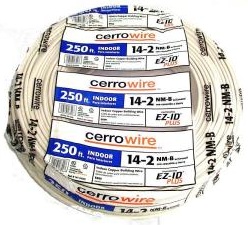
20A House power sockets (dry areas) 120V
Interior Copper NM 12-2 with Ground $65 for 250'
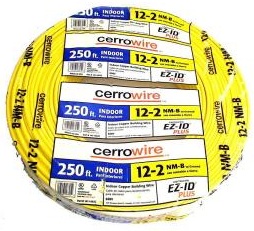
20A Yard power/lights 120V
Sch 40 Conduit, with Solid Copper THWN 12 AWG, 3 insul wires 3 x $65 for 500'
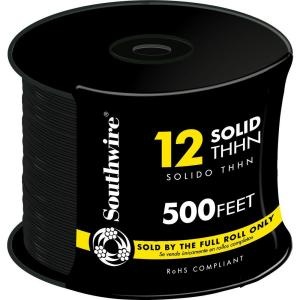

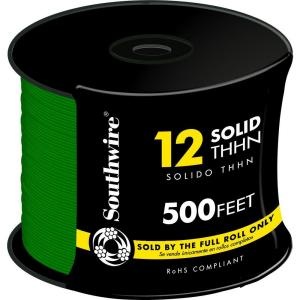
(Note for comparison that 14 gauge is $42 for 500' and 10 gauge is $110 for 500')
20A Shed 240V
Sch 40 Conduit, with Solid Copper THWN 12 AWG, 4 insul wires 4 x $65 for 500'
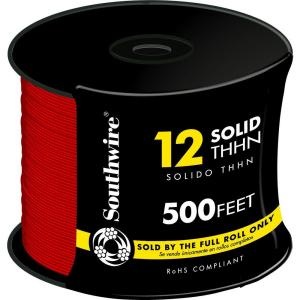



20A Big Electric water heater 240V
Interior Copper 6-3 and earth $208 for 100'
55A Big Electric range 240V
Interior Copper 6-3 and earth $??
40A Well house 240V
Currently I have Exterior
Copper 2/0
with 3 insul wires & earth
4 x $2.17 per foot
But a WellHouse only really needs L1+L2 at
40A, ie 8 AWG.
200A House sub-panel 240V
Exterior
Copper 3/0
with 3 insul wires & earth $2.17 per foot x 3 +
earth
Separate runs to each sub-panel (I have two sub-panels).
If money is tight, fit one run of 3/0 (200A) and provide conduit for
a second sub-panel later.
Lowes is a good supplier of
3/0 wire. If you buy 500 feet then
it is $1.94 per foot.
My house needs about 170 feet to wire from the main panel. The exact length can be established by temporarily pulling 12 gauge wire through the conduit (for temporary power to the house) so the exact length of expensive wire can be ordered.
Panel earth stake
Exterior copper #4 (one daisy chained wire
with no joins)
It is ok by code to use eg #4 bare copper for the earth for a 200A service. It wants to be uninsulated so it is in contact with the ground all the way.
I have two 200A panels in the house, so need to use two #4 bare copper wires.
A 200' roll of #4 copper wire is $197 from HomeDepot.
Speaker wire
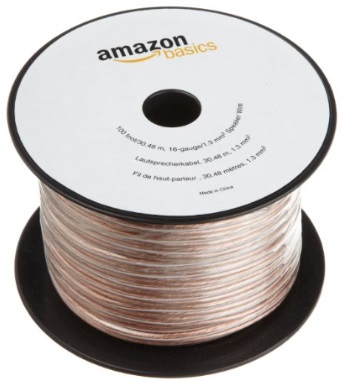 Details are here
.
Details are here
.
Copper price
Copper is a rather volatile commodity on the world market. Lots of the world's copper supply is being used up in China's building boom. When placing a large order for all the wiring in your house it is worth trying to time your purchase when copper prices dip. Below are live charts that gives the price over the last 3 years and 3 months. There will probably be a small delay before any change in the world commodity price changes the price of a bundle of wire in Home Depot, but it absolutely will cause a change. A high price for copper is $4 per pound, but the hope is that it's below $3 per pound. In the 2008 crash it was $1.50 per pound, and if it ever hits that again then I will do a copper roof!
The following chart gives an approximate indication of the trend over the last 5 years.
![[Most Recent Quotes from www.kitco.com]](http://www.kitconet.com/charts/metals/base/spot-copper-5y.gif)
|



